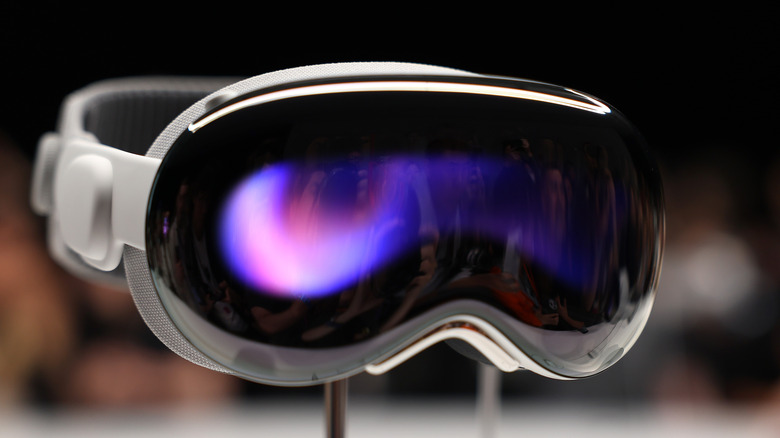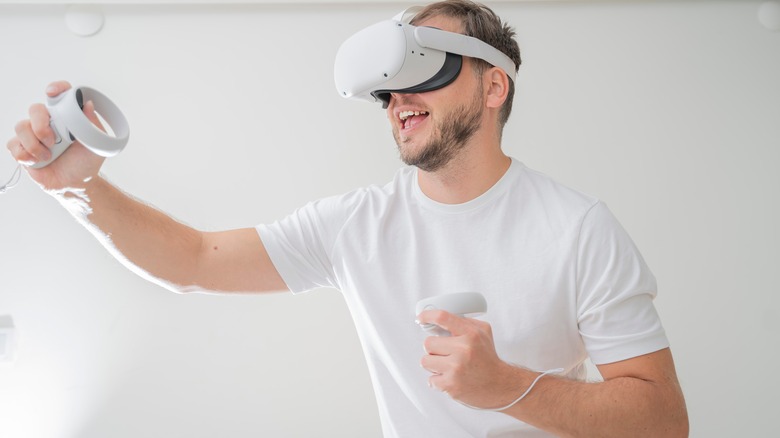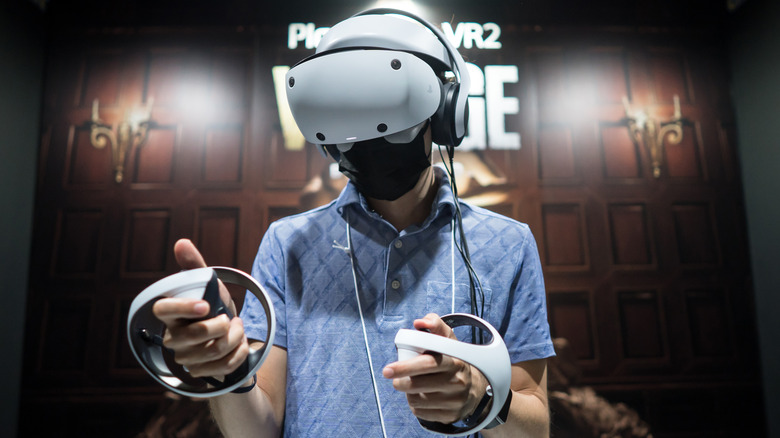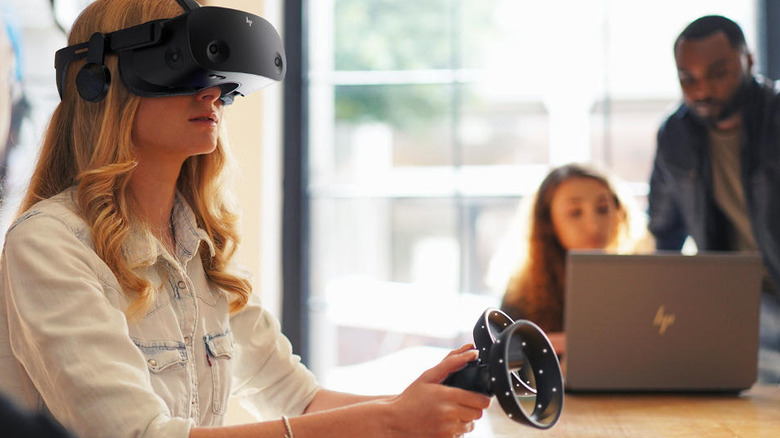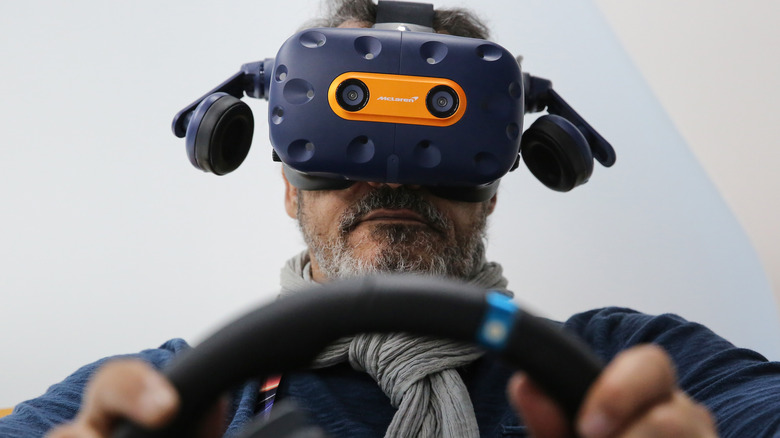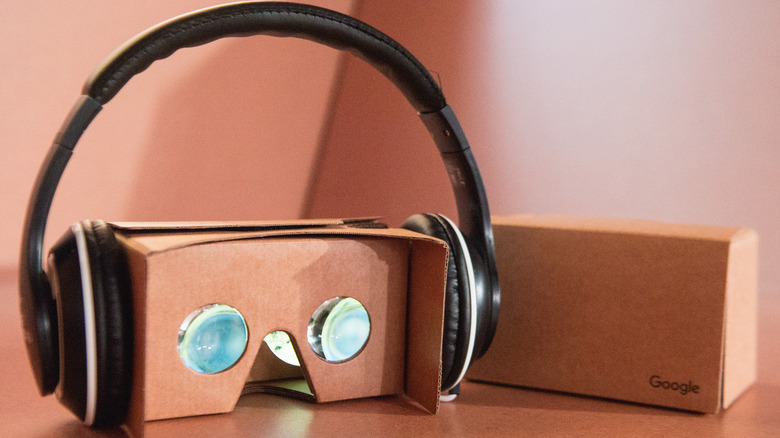5 VR Alternatives Cheaper Than Apple's Vision Pro
We may receive a commission on purchases made from links.
After years of anticipation and speculation, Apple finally revealed its AR/VR headset — the Vision Pro — at the 2023 Worldwide Developers Conference. While the Apple Vision Pro offers extremely impressive specs and innovative tech, you won't be able to get your hands on one until next year at the earliest. And once it is available for sale to the public, its very high price may deter you from buying one, at least right away.
But that doesn't mean you have to wait to experience the futuristic world of virtual or augmented reality. There are several VR and AR headsets by Apple competitors you can buy today, some of which have been around for years. While it's too soon to say whether the Apple Vision Pro will be so advanced it will make these products look antiquated, it's likely many of the things the Apple device will do are already capable by current headsets on the market. Some devices even have features and apps the Vision Pro won't. And because the Vision Pro's cost is so high, nearly every VR alternative is a cheaper option, even high-quality ones that offer the mixed reality experience you may be looking for.
Quest 2, Quest Pro
Facebook is so invested in VR that it was even renamed Meta after the virtual metaverse where Mark Zuckerberg hopes social media will fully expand. That's why it should be no surprise that the VR headsets made by Meta, based on innovations from VR startup Oculus, are some of the best products on the market. The Quest 2 has been especially successful because it's completely wireless and untethered to any computer, giving users more freedom to roam while in virtual reality. It's also lighter and more comfortable to wear than a lot of alternatives, and has a reasonable price of $300.
However, the standalone device doesn't have as impressive specs as its tethered competitors, and may not deliver the VR experience you're looking for. It's also on track to become outdated with the launch of the Quest 3 later this year. Another alternative to the Apple Vision Pro to consider is the Quest Pro, which is similar to the Quest 2 and compatible with the same apps, but delivers a much higher performance. As such, it offers even more of the same features as the Apple Vision Pro than the Quest 2. However, the Quest Pro must be tethered to a computer, which makes it considerably more expensive.
Playstation VR 2
If you're particularly interested in a VR headset for gaming, then your best choice might be the Playstation VR2. The PS VR2 is much more streamlined than its bulky predecessor, comes with more intuitive controls similar to other VR products, and connects to the PS5 with a single USB-C cord. Besides offering fluid controls and solid graphics, there are a lot of great games you can play on the PS VR2, including "Gran Turismo 7" and "Resident Evil Village." Unfortunately, it's not backwards compatible with original PS VR titles, so most of the games you purchased for the original PS VR won't be playable.
While the $550 price tag for the PS VR 2 is reasonable for a headset, it's pretty high for a gaming accessory, and that cost will nearly double if you need to also buy a PlayStation 5 to connect it to. The PS VR 2 isn't built to run with anything else, so even if you own a powerful PC, you still need a PS5 to use your PS VR 2.
HP Reverb G2
While Hewlett-Packard might be more associated with printers and PC laptops, it's also one of the few computer manufacturers to have a proprietary VR headset: the HP Reverb G2. Considering its branding, it's unsurprising that the VR headset is similar to the Apple Vision Pro in that it focuses more on productivity and industrial applications than gaming. Despite this, the HP Reverb 2 has maybe more impressive graphics than any other headset, along with great audio to accompany them. There is a trade off, however, since users report refresh rate and controller tracking issues. Its refresh rate is also limited to 90 Hz, less than most competitors.
The HP Reverb G2 doesn't have access to some of the best games offered by the likes of PlayStation and Meta, but it is compatible with both SteamVR and Windows Mixed Reality. You'll need to tether it to a powerful PC, and the headset sort of falls into a middle ground between the wireless Meta Quest 2 and higher-end sets like the Quest Pro and HTC Vive Pro. This means it's a little more cost effective yet not as powerful as other tethered VR systems, but pricey if you're looking for a more streamlined alternative.
HTC Vive Pro 2
The HTC Vive Pro 2 isn't even half the cost of the Apple Vision Pro, but it's still one of the most expensive VR headsets currently on the market. Its starting price is $1400, but that can go up, because the HTC Vive Pro 2 is customizable and you can pay for extra features like body tracking and the ability to run it wirelessly. But if you're willing to spend the money, you'll get one of the best VR headsets available. The HTC Vive Pro 2 has a surprisingly comfortable design, and some of the best visuals in VR, with a whopping 2448 x 2448 pixels per eye. It works very well with SteamVR, though its controls aren't the best when it comes to gaming.
Like with the Meta Quest Pro, you'll need a fairly powerful PC to run the HTC Vive Pro 2, which will add to your overall cost. Also, it has one of the most complicated setups among VR products. If you're not especially tech savvy, this could be a big turnoff, and you may want to opt for a simpler headset.
Google Cardboard (sort of)
When the VR headset market started out, Google Cardboard offered something slightly different: a headset that would house your smartphone in front of your face, with lenses that could present specially designed mobile apps in 360-degree virtual reality. The device could literally be made out of cardboard and be offered for as little as $15 because your phone would be doing the technical heavy lifting. Google also offered the similar and slightly higher-end Daydream VR. Both devices are now discontinued by Google, and while you can find used ones online, there are still other products on the market with the same idea: an inexpensive VR headset that is less of a computer and more of a container for your phone.
Using your smartphone, you can enjoy 360-degree video and other passive VR experiences pretty much the same as you would with a Quest 2 or other headset. While there's no hand-tracking or even a way to control or interact with most VR apps that work with this type of peripheral, its bargain-priced take on virtual reality is a great entry-level introduction to the medium. You can test the VR waters with a cheap cardboard-like headset before committing to spending hundreds or thousands of dollars on the Apple Vision Pro or its alternatives.
